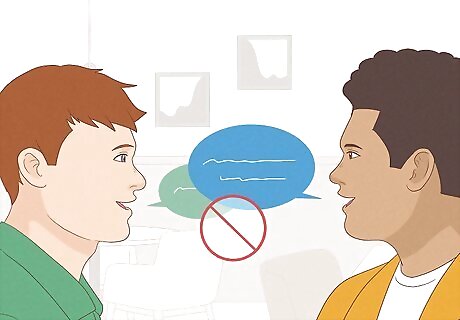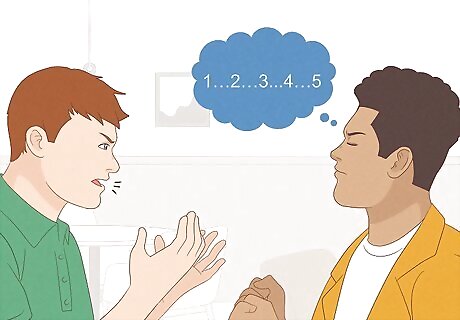
views
Recognizing Social Cues About Emotions

Pay attention to the person’s face. The face is the part of the body that is most likely to show emotions. If you’re trying to determine whether someone is sad, upset, lonely or otherwise in pain, start by looking closely at the person’s facial expression. Unlike some social cues, the seven basic facial expressions are said to be universal in expression across all cultures. These expressions are joy, surprise, contempt, anger, disgust, sadness, and fear. Facial expressions change rapidly, and may communicate more than one emotion at a time. For example, the person’s face may show both amusement and fear if something very surprising has happened.

Learn the signs of sadness. When someone is sad, you’ll likely be able to see it on his face. It won’t look like a cartoon drawn with an upside-down smile, but the corners of the person’s lips are likely to be slightly drawn down, while the jaw comes up. The inner corners of the person’s eyebrows will be pulled slightly inward, and up towards the forehead. Look for the skin below the person’s eyebrow to appear slightly triangulated, with inner corner turning up.

Be aware of signs of fear. Being sensitive to when someone's afraid can help you alter your own behavior. When someone is afraid, her mouth will likely be held open with her lips slightly stretched and drawn back. Her brows are usually raised and drawn together in a flat line. Examine her forehead, and look for wrinkles in the center between the brows, not across. If someone's afraid, the upper eyelid will be raised, while the lower lid is tense. The upper white of the eye will be visible, but not the lower.

Consider body movement and posture. Signs of someone’s fatigue might include slumping shoulders and loosely held limbs. If a person feels defensive, he may cross his hands, or shake his head. If you’re attentive to these cues, you’ll be more aware of another person’s feelings. If you’re not sure if you’re interpreting the person’s body language correctly, it’s usually okay to ask the person verbally. However, if the person himself isn’t aware what he’s communicating, he might respond by telling you everything’s fine when it really isn’t.

Think about what vocal tone might communicate. Most people naturally modulate their tone of voice to suit the size of the room, i.e., in order to be heard. If you’re in a large room, and the person is speaking loudly, it’s likely that she’s just trying to be heard. However, the same vocal tone in a small space can indicate frustration, anger or fear. If the person is finding it difficult to talk, it’s possible that she’s upset or close to tears. If she’s speaking in an arch, overly articulate manner, it’s likely that she’s being sarcastic. Since sarcasm is a form of teasing, this might indicate that she’s angry but trying to pretend not to be.
Listening with Empathy

Clarify that you understand what another person said. Summarizing or paraphrasing what the other person has said will allow you to share your understanding of his meaning, and offer him a chance to let you know if you’ve understood him correctly. If you’ve not understood what he meant, this practice can help prevent misunderstanding. This step might feel like it slows down a conversation. That’s okay, because it will also keep feelings from getting hurt through misunderstanding. However, you can also ask someone to repeat what he's said. Saying, “Excuse me?” or “Would you mind repeating that?” are polite ways to ask someone for clarification. Remember that this will be most important to do when you’re talking about sensitive topics.

Give your full attention to the person speaking. Your undivided attention will increase your sensitivity to another person’s feelings. If you’re looking around the room, or distracted by another activity, you’re unlikely to be tuned in to another person’s feelings. If you’re listening and trying to fix some problem the person has at the same time, then you’re less likely to be able to really hear what the person is trying to say. Trying to help is a kind of judgment. For best results, listen first. Some people can listen more attentively when they’re doing something with their hands, but for other people this might look like inattention. If it is easier for you to listen when your hands are occupied, make sure you let your friend know this.

Listen without judgment. Try to take the speaker’s perspective as she talks, rather than responding from your own point of view. This doesn’t mean that you have to agree with what the other person is saying. It just means that while the person is talking, keep an open mind. Refrain from analysis of what the person is saying until after she has finished. Think about who’s talking. If you’re really paying attention to someone as she talks, you’ll also be better able to consider why they’re saying what they are saying. For example, if the person is a mother of a teenager who’s been in trouble, she may be more anxious and judgmental about moral behavior.

Use good manners. Being pleasant and courteous to other people is a good way to be respectful. Most of us teach children to say “please” and “thank you” to people as a way to show politeness. Remembering the basics of etiquette will help keep you from accidentally hurting someone else’s feelings. Good manners also include careful listening and sensitivity to someone else’s feelings. For example, refraining from interrupting another person while he’s talking, or nodding to show agreement and understanding are ways that polite behavior can show respect for another person. One of the things that many children are taught is the adage, “If you can’t say something nice, don’t say anything at all.” While this may not always be appropriate advice, a thoughtful restatement of the adage could be, “If you can’t say something nice, consider saving your comment to share later with someone else.”

Acknowledge what the person has said. You can do this in many different ways. For example, you can repeat the person’s statement, nod to show you’re listening, or offer encouragement for the person by saying, “Yes,” or “I hear you.” All of these affirm to the speaker that you’re engaged in the conversation, and that the person’s feelings are important to you. Acknowledging what the person has said doesn’t mean that you always have to agree with her statements. Even if you strongly disagree, you can respectfully acknowledge the person’s perspective. It’s important to communicate gently on sensitive topics.

Don’t respond too quickly. If you’re involved in an emotional conversation, it can be easy to get caught up in your own feelings. This increases the likeliness of saying something that hurts another person’s feelings. Chances are high that you’ll say something you later regret. Instead, when you feel yourself getting heated, take a deep breath before responding. Count to five internally. Research shows that when your pulse goes above 100 beats per minute, you’re more likely to make poor word choices. If you feel like you can’t calm down, it’s okay to take a break from the conversation.
Communicating Kindly

Ask questions. Asking questions is a great way to learn more about the perspective of the other person. Questions will also allow the person to indirectly know that you value his thoughts and feelings. Being open to whatever the person might have to say is a sign of compassionate communication. Make sure your questions are open-ended, allowing the person to choose how to respond. Leading questions, or questions that are attempting to persuade someone else of the correctness of your own point of view, don’t show respect for the other person’s feelings. If you ask questions that can be answered with yes or no, make sure you allow the person time to provide additional clarification if he chooses.

Choose the best way to express your feelings. It’s vital that you have a way to express your emotions, but in order to be sensitive to another person’s feelings you may have to take care in how you do this. Sticking to statements that start with “I” will help you say what you’re feeling without appearing to blame another person. For example, “I’m feeling sad about what you just said, because it reminds me of an experience I had in high school…” will be kinder than “You’re wrong, because when I was in high school, this happened to me.” If you’re expressing empathy with the other person in the conversation, chances are he’ll be able to respond to your feelings with empathy as well.

Affirm the positive when offering criticism. When offering feedback, make sure to offset any negative criticism with an equal or greater affirmation of what you find the person doing well. Be very free to find areas that you feel you can genuinely appreciate, and be sparing (but direct) with any criticism. Being sensitive to someone’s feelings doesn’t mean pretending to be someone you’re not. However, before you offer your opinion or ideas about another person’s experience, always check and make sure that the person wants your honest opinion. Focusing your feedback on the person’s actions, rather than who she is as a person, may help prevent hurt feelings.

Avoid platitudes and cliches. If a person is going through a hard time, try not to say things like “Everything happens for a reason,” or “I know exactly how you feel.” Your intentions may be good, but telling someone that his bad experience may be “a blessing in disguise” is insensitive to your friend’s feelings. Instead, acknowledge the person’s feelings. Some variation of “I’m sorry this happened,” is likely to be met with appreciation, as are statements like “What you’re going through sounds really hard.” It’s okay to let him know that you don’t know what his experience is like. If you’ve been through something similar, acknowledge that what he's going through may be different from your own.

Use body language to communicate respect. Your nonverbal communication may be even more important to another person’s interpretation of your message than your words. While the particulars of body language will vary by culture, in general the following are suggested as a way to communicate respect: Making frequent eye contact while you speak. This will allow another person to realize that you’re sincerely attempting honest communication. However, eye contact shouldn’t be sustained for long periods of time, or it may be interpreted as aggression. Direct your body towards the other person as you talk. Intermittent, light touches on the person’s outer arm may communicate friendliness and support. More sustained pressure may not be welcome, or may feel either aggressive or flirtatious. It can be a good idea to ask someone if it’s okay before offering even a light touch. Then, respect the person’s response. Keep your arms uncrossed and relaxed. Make sure your facial muscles are relaxed, and smile if this comes easily to you.
Taking Care of Your Own Feelings

Become aware of your feelings. If you’re going to be sensitive to other people’s feelings, the best place to start is to become aware of your own. If you’re unaware of how you’re feeling during a heated or sensitive conversation, you’re less likely to be able to respond sensitively to others. Learning to recognize the signs of fear, anger, anxiety, and sadness in yourself will help you more easily empathize with others’ feelings. Pay attention to concrete signs of your own feelings. For example, notice if your palms start to get sweaty, or if you start to shake. Does your stomach start to ache as your anxiety increases? Does your breath become shallow?

Learn coping skills. When you notice signs of strong emotion, you’ll need to know ways to manage your feelings so that they don’t overwhelm you. Whether you cope with your feelings by taking deep breaths, talking to a therapist or a trusted friend, or a combination of approaches, the most important thing is that you allow yourself to acknowledge your feelings in a healthy way. It can help to remind yourself that strong feelings aren’t wrong or bad. If you’re feeling guilty for having strong feelings, this will only compound your stress. Having a regular exercise routine will help you cope with strong emotions as well.

Protect yourself. If you start to feel overwhelmed, it’s okay to take a break. Your ability to be sensitive to another person’s feelings will diminish if you’re not able to take care of your own feelings. If there are people or topics that you can’t avoid, make sure to allow yourself time and space to recover afterward. Realizing that sometimes topics are hard for you because you need to pay attention to them might help you put your own feelings in perspective. Take a calming walk, spend time playing with your dog, or just take time to sit by yourself breathing deeply.




















Comments
0 comment